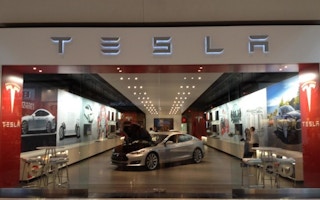When Bem Ho discovered the minivan he drives doesn’t earn him much respect, he ordered a set of wheels that will turn more heads: a Model S electric sedan from Tesla Motors Inc. (TSLA)
“I’m getting sick of driving my van because when people see the car they always think I’m a chauffeur,” said Ho, who runs an apparel manufacturer in Hong Kong. “It’ll be like a talking point when you go out: ‘Oh that’s an electric car.’”
Ho is among the 300-plus Hong Kong residents who have made refundable deposits of HK$39,000 to HK$330,000 ($5,000-$42,500) to reserve a Model S, even before the company has said how much the cars will cost. That’s more orders than Tesla has seen in the U.K., Japan or Australia, sales manager Kenneth Lui said.
The Hong Kong success may bode well for the Palo Alto, California-based company in mainland China, where it plans to open a Beijing showroom this year.
“While the influence of Hong Kong toward mainland China has decreased compared to the 90s, it should still contribute to the development of the brand in China,” said Pablo Mauron, China general manager at market researcher Digital Luxury Group.
Tesla, the electric carmaker founded by billionaire Elon Musk, will find ample company at the high end of the world’s largest auto market. Luxury vehicle sales there are dominated by Volkswagen AG’s Audi, Bayerische Motoren Werke AG and Daimler AG’s Mercedes-Benz, but they face a growing challenge from General Motors Co.’s Cadillac, Nissan Motor Co. (7201)’s Infiniti and Tata Motors Ltd.’s Jaguar Land Rover.
Warren Buffett
As a maker of only electric vehicles, Tesla faces bigger hurdles than most of its competitors. Consumers in China are put off by the price of electrics, and with just 168 public charging stations nationwide, they fret that battery-operated cars might run out of power before they reach home.
While China’s central government is targeting cumulative sales of 5 million electric vehicles by 2020, automakers sold just 12,791 of them last year, Bloomberg New Energy Finance reports.
Until last year, the central government offered subsidies of as much as 60,000 yuan ($9,800) toward the purchase of electrics, with some cities adding sweeteners. In Shanghai, the total rebate could top 175,000 yuan, according to Bloomberg New Energy Finance. Since the government support lapsed last year, though, it hasn’t been renewed.
The aid helped boost sales at BYD Co., the Chinese automaker that counts Warren Buffett’s Berkshire Hathaway Inc. as a shareholder. In its hometown of Shenzhen, 800 of BYD’s e6 electrics are used as taxis, while its electric buses are in operation in several cities.
Plush backseat
The e6 costs 369,800 yuan without subsidies, versus a starting price of 349,900 yuan for the Cadillac XTS sedan, according to pricing data from autohome.com.
Musk has also said the company is mulling a factory in Asia, where it might make a smaller and cheaper model. For now, though, the cars it sells in Hong Kong will be made in California.
To attract buyers in mainland China, Tesla plans to make the rear seat of the Model S more luxurious since many wealthy Chinese have drivers, Musk said on an Aug. 7 conference call. The automaker started taking reservations in China this week.
The Model S was designed “to be the perfect driver’s car,” Musk said, according to a transcript of the call. “Obviously if people are being driven around, then we need to make sure the back seat is optimized.”
Short commutes
Hong Kong offers advantages that Tesla won’t find in the mainland. While the territory is controlled by China, it remains largely isolated by geography and culture. Hong Kong’s main island is less than 10 miles wide — well within the range of the Model S, which Tesla says can travel more than 300 miles on a charge. It’s rare for Hong Kong commutes to extend beyond 20 miles, and since the territory’s British colonial masters left a legacy of driving on the left side of the road, it’s inconvenient for the city’s drivers to venture into neighboring areas of China.
“Although there’s strong demand for luxury, the circumstances are completely different in mainland China from Hong Kong,” said Michael Dunne, head of auto consultancy Dunne & Co. “In China, you got a continental-sized market.”
Hong Kong has just over 300 electric vehicles on its roads, versus more than a half-million gasoline-powered cars, according to the Transport Department. In mid-2012, the city had roughly 1,000 charging stations in shopping centers and parking lots, the Environment Bureau says.
Tesla hasn’t said how much it will charge in Hong Kong for the Model S, which starts from $62,400 in the U.S. after a federal tax credit. Nissan Motor Co. says it has sold some 240 electric Leafs in the city, priced at HK$450,000 ($58,000).
Nasty look
For Philip Liang, chief executive of Hong Kong-based medical-device manufacturer General Sensing, driving a luxury car with green credentials is a bonus.
“Even Prius owners like you,” said Liang, who placed an order for the Model S to replace his BMW 535 sedan. “If you drive a Ferrari, people will give you a really nasty look. But if you drive an electric car, everybody’s going to be happy.”










